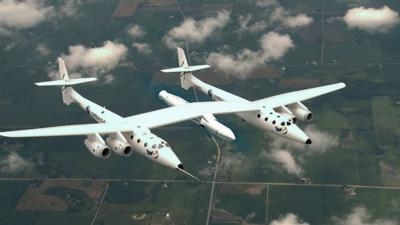Fri, Jan 16, 2015
WhiteKnightTwo Reconfigured To Carry LauncherOne
While every other gadget in our lives has gotten smaller, lighter, and cheaper, satellite technology has somehow gotten bigger, heavier, and more expensive since the days of Sputnik and Explorer I. But now, thanks to the recent advances in Cubesats and microsatellites, commercial satellite start-ups, universities, schools, and even IndieGoGo campaigns can put their own satellites into space. But small satellites need small satellite launch vehicles—after all, small satellites cannot truly change the world without cost-effective, frequent rides to space!

Current small and microsatellites reached space mostly by “hitchhiking” — catching a ride on someone else’s big, expensive rocket. But hitchhiking to space has real drawbacks: just like hitchhiking here on Earth, when you leave and where you get dropped off aren’t your decisions to make, and the driver probably has strict rules about what you can and can’t do in the vehicle. If you are just trying to prove that your satellite works in space, those restrictions may be fine, but if you are trying to build a business or accomplish a mission, you need your own ride, at the right price.
The makers, builders, and satellite entrepreneurs have done their part. It’s time for the rockets to do theirs. Sir Richard Branson says it’s time for LauncherOne.
Virgin Galactic, says they are leveraging its work building their human spaceflight program and its team’s extensive background in low-cost launch systems to create LauncherOne, an orbital launch vehicle dedicated to the small satellite market. By using much of the same infrastructure originally that supports SpaceShipTwo — in particular WhiteKnightTwo, our unique, high-performance mothership — the company says it can keep prices low while accommodating customer needs for launch availability and flexibility.
Branson said on the Virgin Galactic website that they are "hard at work finalizing the design for LauncherOne and testing its key components. LauncherOne will be a two-stage rocket, built using advanced composite structures, and powered by our new family of LOX/RP-1 liquid rocket engines. Each LauncherOne mission will be capable of delivering as much as 225 kilograms (500 pounds) to a low inclination Low Earth Orbit or 120 kilograms (265 pounds) to a high-altitude Sun-Synchronous Orbit, for a price of less than $10M. The customers we’ve already announced plan to use LauncherOne to take pictures of the Earth for humanitarian causes, to collect more accurate weather measurements, to hunt for asteroids that could represent threats and opportunities to our home planet, and to launch many other types of satellites. We’re convinced that the types of missions are only the tip of the proverbial iceberg."
More News
From 2014 (YouTube Version): One Of The Airshow World's Pre-Eminent Formation Teams Chats About The State Of The Industry At EAA AirVenture 2014, ANN News Editor Tom Patton gets th>[...]
Tactical Air Navigation (TACAN) An ultra-high frequency electronic rho-theta air navigation aid which provides suitably equipped aircraft a continuous indication of bearing and dis>[...]
Aero Linx: Doobert Hi, we're Chris & Rachael Roy, founders and owners of Doobert. Chris is a technology guy in his “day” job and used his experience to create Doobe>[...]
The Airplane Was Spinning In A Nose-Down Attitude Before It Impacted Terrain On June 20, 2025, at 0900 eastern daylight time, a Pitts Aerobatics S-2B, N79AV, was destroyed when it >[...]
Also: United Elite Sues, Newark ATC Transitions, Discovery Moves?, Textron @ KOSH The Commemorative Air Force Airbase Arizona is taking its “Flying Legends of Victory Tour&rd>[...]
 Classic Aero-TV: Up Close And Personal - The Aeroshell Aerobatic Team at Oshkosh
Classic Aero-TV: Up Close And Personal - The Aeroshell Aerobatic Team at Oshkosh ANN's Daily Aero-Term (07.13.25): Tactical Air Navigation (TACAN)
ANN's Daily Aero-Term (07.13.25): Tactical Air Navigation (TACAN) ANN's Daily Aero-Linx (07.13.25)
ANN's Daily Aero-Linx (07.13.25) NTSB Prelim: Pitts S2
NTSB Prelim: Pitts S2 Airborne 07.09.25: B-17 Sentimental Journey, Airport Scandal, NORAD Intercepts
Airborne 07.09.25: B-17 Sentimental Journey, Airport Scandal, NORAD Intercepts



